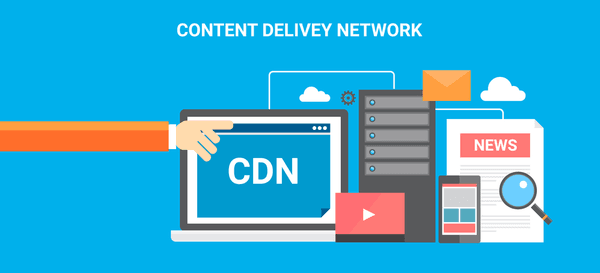
Advantages and Disadvantages of Using a CDN
October 29, 2018
What Are the Security Implications of Smart Assistants?
October 31, 2018Owners of SMB’s websites debate whether CDN is a worthy investment. There is a lot of contradictive information online, so it’s pretty hard to make a final decision. If you want to learn about the major advantages and disadvantages of using a CDN, just keep reading.
What exactly is a CDN?
Contact Delivery Network is a system of servers, which are located in the different geographical regions around the world. All of them store and cache the copies of the website’s CSS, HTML, JavaScript, images and other static content.
When a user tries to access a website, the system sends content from the closest location. For example, if there are servers in Melbourne and Paris, and a user hits a webpage from Monaco, then content comes from Paris. It makes asset’s delivery time shorter, so a visitor doesn’t leave a website because of the slow load speed.
Advantages of using a CDN
The boosted speed of content delivery
Modern users are very impatient and they tend to leave a page if it loads for more than 4 seconds. This is a great problem for the small business websites’, which struggle to grab the attention of every potential client. A CDN was created with a purpose to solve this topical issue.
It boosts the speed load by decreasing latency and minimizing packet loss, so a visitor can get access to content faster than ever before. It helps to make a great first impression on a user and ensure that he will get back to the site again.
To make CDN works effectively, it’s important to choose providers, which have the POPs (points of presence) in the targeted region. For example, if a company expects to get the most of the traffic from China and Japan, CDN must have POPs in these countries or at least somewhere in South Korea or Mongolia.
Improved ranking
SMB’s websites face numerous difficulties trying to compete with the leaders of the industry. For this reason, they take SEO seriously and try to optimize a website in every way possible. A CDN is one of the most effective tools, which can help in this situation.
A CDN improves the page ranking because of the few reasons. Firstly, Google considers webpage load time as an important factor. So, when CDN boosted the speed of content delivery, it positively influences the website’s ranking.
Secondly, it allows serving the assets over HTTPS while not hosting the main site over HTTPS. Thirdly, CDN helps to index the images in few times faster in the search engine results pages.

Lower network load
A CDN helps to lower the network loads and, consequently, improve the performance. It allows for a bigger number of users to visit a website simultaneous without facing any glitches or bugs. A CDN helps to maintain stable work during the peaks of activity, preventing server overload.
As a result, CDN significantly improves user experience and drives conversion rates. When the system is balanced, then there are no network disruptions, which usually scare visitors away. If a website is powered by CDN, it works faster than other similar sites and attracts more visitors.
Enhanced Security
Security is the priority number one in the digital world. CDN is a great way to make content more protected from the hacking attacks. This type of system not only effectively blocks known attacks at the CDN layer, but also distributes DDoS attacks across the wide server’s network.
Every CDN has its unique strategy to mitigating vulnerabilities and avoid unexpected data breaches. But the most widespread method is SSL/TLS encryption. Thanking the cryptographic protocol, only the recipient is authorized to decode and process the transmitted data.

Precise data analytics
Most of the CDNs’ clients can get a detailed usage report, which explains how effectively content delivery works and in which way invested money is used. Availability of this data is very important because the precise evaluation of the current performance metrics can help to take a website to the next level. These kinds of reports are useful for professional analysts, who can define the hidden issues, which take a website’s ranking down.
Disadvantages of using a CDN
High cost
Well, CDN services are not cheap and not every company can afford it. It works great for multinational corporations because they have enough money to pay the extra bill. But for small businesses CDN is a financial burden.
In fact, CDN costs will be justified, only if a company really interested in targeting the global market. If traffic of SMB’s website consists of local users by 85% and overseas users only by 15%, there is no sense to make an investment. But if more than 50% of visitors hit the web page from multiple countries located across the globe, CDN is a reliable solution.
Blocked access
The problem is that legal and commercial requirements vary from country to country. Sometimes it happens that local authorities block IP address of CDN services.
This issue can significantly affect the small business, especially if it targets the “problematic regions” such as Cuba, Sudan, and Iran. When one country implies sanctions against another one, CDN causes the problems instead of bringing benefits.
Moreover, the customer’s network also can block the CDNs because of the spamming or other serious technical issues. In this case, only a part of the users will see that a site doesn’t work correctly. As a result, it will be hard or even impossible to diagnose this problem and fix it.
Bottom line
A CDN is a great solution for the websites which operate globally and struggle to boost the speed of content delivery. It helps to significantly improve the SEO ranking and user experience. However, a CDN isn’t a cheap solution, so it’s not always the right choice for SMB’s website.
Small business owners should consider CDN as a real investment opportunity, which should be examined in details. It’s crucially important to calculate potential ROI to make a final decision. There is no doubt that CDN will influence a company in a positive way, the question is whether obtained profit will exceed the investment.
